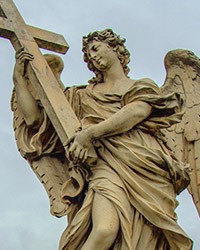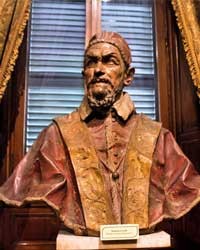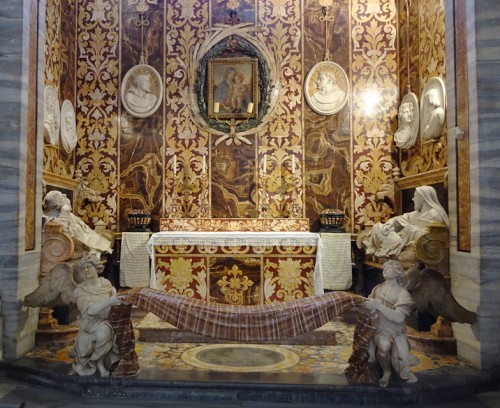
Spada Chapel, Church of San Girolamo della Carità
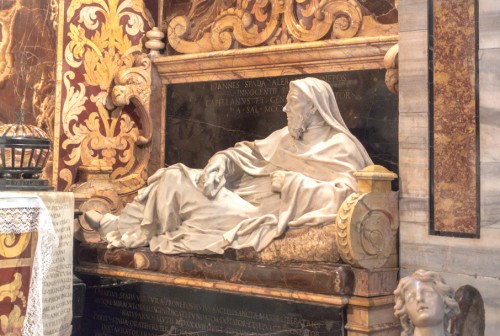
Spada Chapel, tombstone of Giovanni Spada, Cosimo Fancelli, Church of San Girolamo della Carità
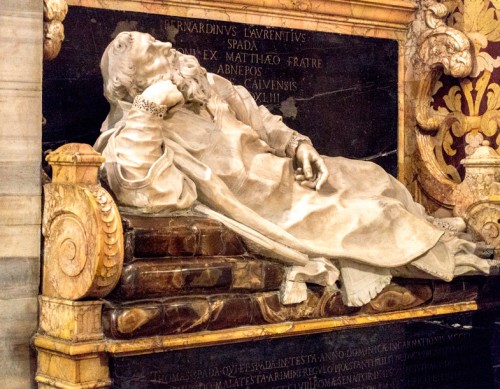
Spada Chapel, tombstone of Bishop Bernardino Lorenzo Spada, Ercole Ferrata, Church of San Girolamo della Carità
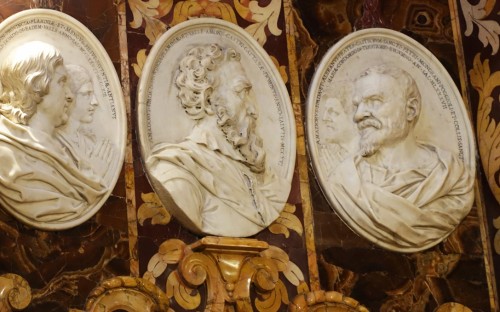
Gallery of famous representatives of the Spada family, Spada chapel, Church of San Girolamo della Carità
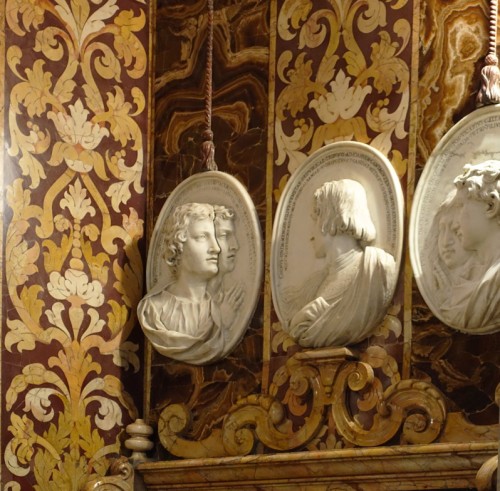
Gallery of famous representatives of the Spada family, Spada chapel, Church of San Girolamo della Carità
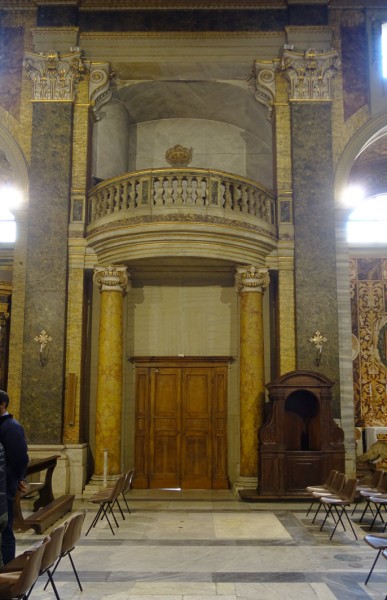
Entrance to the church of San Girolamo della Carità, on the right the chapel of the Spada family
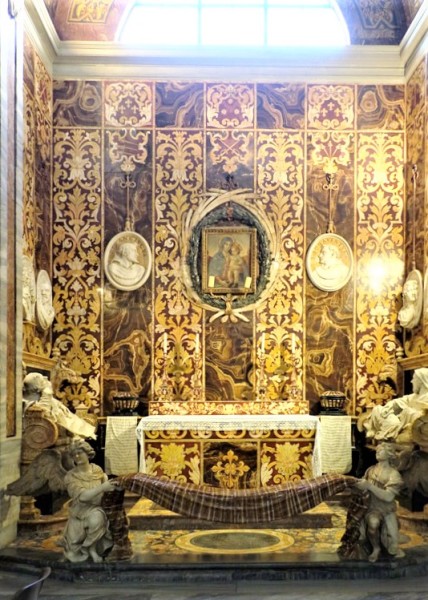
Spada Chapel, Church of San Girolamo della Carità
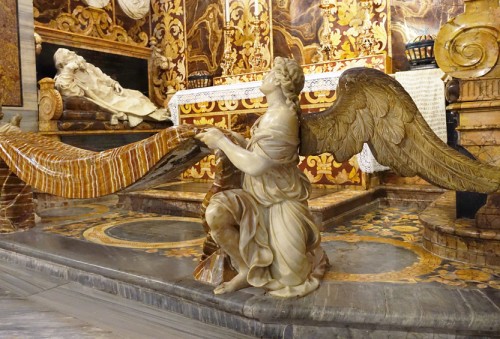
Angels in the chapel of the Spada family, Church of San Girolamo della Carità
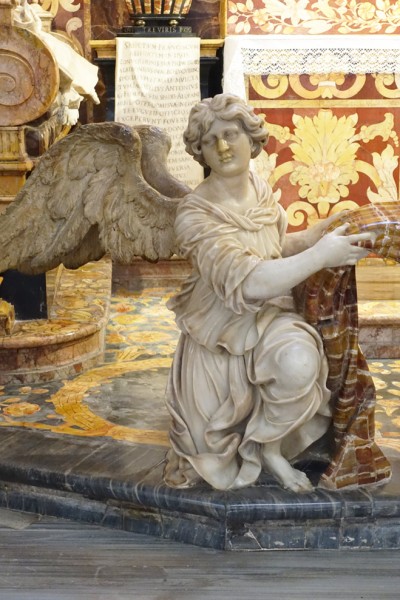
Spada Chapel, an angel supporting the cloth at the entrance to the chapel, Church of San Girolamo della Carità
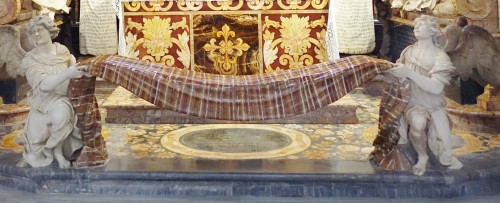
Angels in the chapel of the Spada family, Church of San Girolamo della Carità
Numerous posthumous chapels, which we can see during a pilgrimage through Roman churches are generally filled with decorations and works of art. They arouse our respect, and approval, and let our thoughts linger on the grandeur and significance of the family, but above all their sense of art. It is quite seldom that we think about them in purely practical categories, not to say mercantile. It is a rare situation indeed that we can say that the main motive of their creation was not only the desire to immortalize one’s fame, but also the prestige of future, yet unborn successors of the family name.
Numerous posthumous chapels, which we can see during a pilgrimage through Roman churches are generally filled with decorations and works of art. They arouse our respect, and approval, and let our thoughts linger on the grandeur and significance of the family, but above all their sense of art. It is quite seldom that we think about them in purely practical categories, not to say mercantile. It is a rare situation indeed that we can say that the main motive of their creation was not only the desire to immortalize one’s fame, but also the prestige of future, yet unborn successors of the family name.
The social and political life in Rome (the capital of the State of the Church) was uncertain and memory was short. In the heavily competitive struggle for survival, a chapel and a funerary monument gave the black aristocracy a possibility, and a guarantee of eternal stability. This particularly concerned families who "suffered" due to their status as newcomers and a lack of aristocratic roots – such as for example those of the Colonna family. The lesser the knowledge of the family name, the greater the monument and posthumous chapel built by its members – and the greater claims it had to be ennobled. The Colonna name is not connected with any significant funerary monument in Rome, since most likely the family did not need such a symbol of its social status. This was all well-grounded in years of tradition as opposed to the wealthy Spada family, whose representatives were considered upstarts in the city on the Tiber. Thanks to the cleverness and the financial skills of Paolo Spada, and the hard work of his son, Cardinal Bernardino Spada, the family occupied a significant position in the Roman social landscape of the mid-XVII century, which was testified to by the beautiful, enormous palace in the city center (Palazzo Spada), as well as the art gallery found within and the majestic family portraits (see: The Portrait of Bernardino Spada, Guido Reni). The only thing that was lacking was a significant location that would recall the family genealogy. A family chapel provided a great opportunity to deal even with such a difficult problem. An idea for its creation, to commemorate family members, hatched itself in the minds of two brothers – Virgilio Spada (an Oratorian) and the aforementioned Cardinal Bernardino Spada. Both kept a watchful eye on the undertaking, which today would be called a historical policy of the family. However, they had to be careful not to be ridiculed. Rumors in Rome claimed that the ancestors of the Spadas were farm workers and coalmen.

Therefore, the beginnings of the family could not be, although that was the reality, derived from the nouveau riche father Paolo Spada, but had to reach far back into history. A feverish search was started through chronicles and documents to find ancestors with the surname of Spada (epee in English). When this turned out successful, the brothers began their search for an appropriate location. Ultimately they chose a small, shallow chapel (2 x 6 meters) in an equally small Church of San Girolamo della Carità. And even though there was a possibility of choosing a larger chapel in the same church – found next to the main altar – it was decided to take the smaller one, without a view of the altar, which was important in those times, and in addition located immediately next to the main entrance. However, it had its advantages. The family had owned it since 1595, when Orazio (Paolo's brother) was laid to rest in it, and apart from that, it was quite bright and could make an impression due to an effect of surprise, which is what the siblings hoped for. Its modernization began in 1654 according to the plans of Virgilio Spada himself, who was an amateur architect. In fairness, he did consult his sketches and ideas with such architects as Francesco Borromini and Pietro Cortona, but it was his concept that dominated the furnishing of the chapel, and he was in fact its true author. We must agree that it is thoroughly original and unlike anything that had been created in the city on the Tiber at that time. First of all, encrusted marble (pieta dura) in golden brown colors was purchased. It appears as wallpaper placed in decorative stripes of stylized acanthus leaves, garlands, and fleurons on three chapel walls. They are reminiscent of the fashionable at that time textile decorations with such patterns and colors, used in the decorations of palace chambers. Marble medallions were placed upon them. In the central part, we see Our Lady with Child surrounded by saints Francis and Bonaventura. On the shorter sides, there are medallions with portraits of lesser and greater ancestors bearing the Spada name – three portraits on each side.

However, the principal element of the furnishings is two sarcophaguses. One of these commemorates Bernardino Lorenzo Spada active in the XVI century – a bishop of the small town of Calvi, the second Giovanni Spada, an official at the court of Pope Innocent IV, found in the Church archives. The artists who were employed to complete these sculptures were well-known but not top-tier. It would have been a sign of arrogance to employ Gian Lorenzo Bernini, who was a megastar of those time and worked for the pope. Ultimately the monument of the bishop from Calvi was completed by Ercole Ferrata, while the monument of the thirteenth-century papal official Cosimo Fancelli. Both sculptors enjoyed fame and were close collaborators of Bernini.
The chapel does not give off the impression of a family necropolis, but more a living room in which two men in reclining positions rest – one seems to be sleeping, the other gazing forward. In an elegant room, lined with jasper, marble, and alabaster, the two ancestors seem to be expecting our visit. The angels, chiseled in marble, kneeling at the chapel entrance, greet us as if they were servants. The fabric they hold in their hands looks like a tablecloth which they are going to spread on the table in order to host us. Was this the brothers' intention – to host the residents of Rome, to show them the splendor of this place? Did they want to impress the public with the exquisite and fashionable interior? And were they aware of the slightly comical nature of their work?

In comparison with all other family chapels in the Eternal City, the Spada Chapel is a thoroughly original place, although fancy and made-up, created with the single aim to justify the family status and significance. This place has nothing to do with mourning and thoughts of death because none of the ancestors commemorated there (apart from Orazio Spada) existed in the collective imagination of the family until the actual chapel was created. And it appears that Bernardino Spada was right when in a letter to his brother Virgilio he wrote that "father will not fit this place”, since the place itself was an empty tomb – a mirage.
The chapel, is, therefore, an excellent example of the subtle concept of combining the past with the future and retrospective with perspective, which were often the reason for such types of investments in Rome. It was not to commemorate the dead but to ennoble the living and those who are yet to come and will bear the Spada name. This was the capital upon which new goals can be established. One of these was the papal tiara for Bernardino Spada, and the other – was the most beneficial marriage arrangements with the best Italian families, which were either implemented or planned. This asset was something that subsequent generations could take advantage of recalling the Fama (fame) of their ancestors.





























